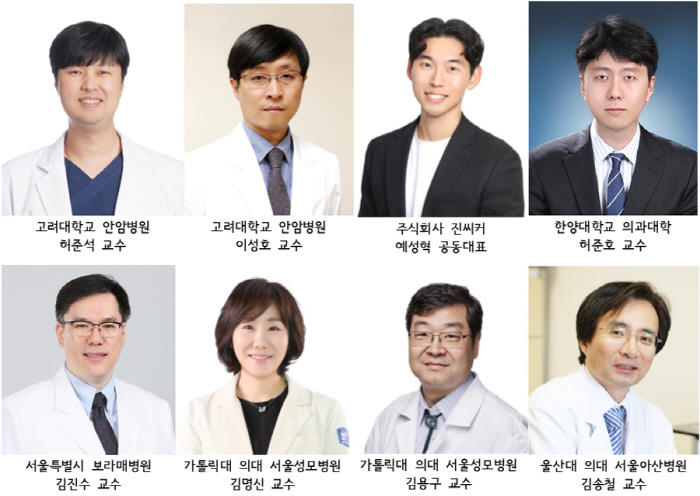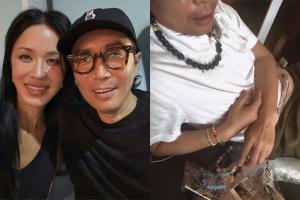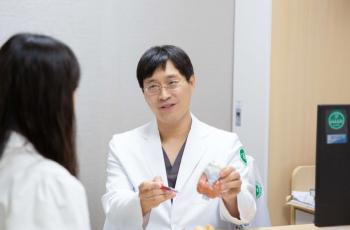Development of cancer screening and recurrence monitoring technology with blood...Precision capture of cancer signal
Aug 27, 2025
A liquid biopsy source technology 'MUTE-Seq' that accurately captures a very small amount of cancer mutation signal (ctDNA) in the blood has been developed.
Korea University Anam Hospital (Professor Heo Jun-seok/Director of Genetic R&D Center, Professor Lee Seong-ho of Cardiovascular Surgery) and Jin Cker (CEO Ye Sung-hyuk) are the results of the study of top medical scholars in Korea (Professor Heo Jun-ho of Hanyang University School of Medicine, Professor Kim Jin-soo of Boramae Hospital in Seoul, Kim Myung-shin and Kim Yong-gu of Catholic University School of Medicine Seoul St. Mary's Hospital, and Professor Kim Song-cheol of Ulsan University School of Medicine).
Liquid biopsy is a non-invasive test that analyzes cancer-related genetic information in body fluids such as blood. Existing methods required ultra-deep sequencing and special barcoding (UMI) to find extremely low-frequency variations, which were expensive and time-consuming, and were buried in normal DNA signals, making it difficult to miss a very small amount of cancerous ctDNA or to manage false positives.
The method developed by the research team'MUTE-Seq' processes high-precision genetic scissors 'FnCas9-AF2' that distinguish discrepancies in single bases during preprocessing to selectively remove normal DNA before testing, leaving only ctDNA, a cancer mutation signal, to make it clear. Since the analysis is performed on samples in which only mutations are concentrated, the detection rate of ultra-low frequency cancer mutation signals is much higher and more accurate than conventional methods.
In addition to precision, improvement in inspection economy can also be expected. The existing method is to raise the volume to the maximum with an expensive high-power speaker (expensive sequencing equipment) to hear very small speech sounds (ctDNA), but the problem is that the ambient noise (normal DNA) also increases, so it is still expensive while not being able to distinguish speech sounds well.
In contrast, 'MUTE-Seq' is an innovative 'noise cancellation' method. Thanks to ultra-precise genetic scissors that accurately reduce ambient noise (normal DNA), it allows us to hear only the desired speech (ctDNA) louder and clearer, regardless of the speaker's performance (all kinds of sequencing equipment are available) with less power (low sequencing cost). In other words, if unnecessary normal DNA signals are removed and sequenced as much as possible, the amount of sequencing is drastically reduced while the signal of the mutant ctDNA is amplified dozens of times. As a result, the precision can be improved 20 times compared to the existing method, while the inspection cost can be reduced to 1/10.
The research team applied this technology to actual patient blood to confirm its performance. Cancer tissue-blood mutation concordance was explored, with 91% sensitivity and 95% specificity in lung cancer patients. In pancreatic cancer patients, the sensitivity was 83% and the specificity was 100%. After treatment in patients with acute myeloid leukemia, a very small amount of cancerous variant DNA could also be detected in the follow-up monitoring test, and it succeeded in diagnosing microresidual cancer with 100% sensitivity and 100% specificity.
The results were mainly for patients with early cancer (phase 1 and phase 2) and microresidual cancer, showing a high possibility of diagnosing cancer early with blood alone or confirming recurrence faster than imaging equipment such as CT.
Heo Jun-seok, a professor at Korea University's Anam Hospital's Neurosurgery/Genetic R&D Center, emphasized, "How quickly cancer is detected and how closely it is examined after treatment determines the survival rate. If you can read even a few cancer signals with just one blood session, you can detect them earlier and quickly detect signs of recurrence after treatment." In addition, he expressed his expectation that `if the burden of testing is reduced, the threshold will be lowered to the region, the elderly, and the vulnerable, which will also help medical equity and benefit the health benefits of society as a whole beyond individuals.'
Following the April 2025 oral announcement by the American Cancer Research Society (AACR), the world's most prestigious cancer society, the study was adopted and selected as a representative cover paper in the field of materials science 'Advanced Materials' and is recognized worldwide for its clinical and academic importance.
In addition, Jin Seeker Co., Ltd., a domestic company specializing in cancer diagnosis through blood dielectric analysis, led it to the commercialization stage. Microresidual cancer monitoring of leukemia patients is already being used at Seoul St. Mary's Hospital, and cancer cell exploration tests (oncodipscan), which are multi-cancer early tests (9 males and 11 females), can be tested at many university hospitals and hospital health examination centers, including Korea University Anam Hospital.
Professor Heo Jun-seok said, "Just as AI has come to us at some point, blood biopsies are also true in the field of cancer. Thanks to these technological innovations, blood biopsies are increasingly important in early cancer screening and monitoring recurrence", he explained. "We are currently conducting clinical research with leading hospitals such as Korea University Anam Hospital, Seoul National University Hospital, Seoul Asan Hospital, and Seoul Boramae Hospital to introduce blood biopsies to monitor microresidual cancer in solid cancer patients such as colon cancer, lung cancer, pancreatic cancer, breast cancer, stomach cancer, and ovarian cancer. It is an immediate task and goal to prepare to help many people suffering from cancer as soon as possible through systems such as innovative medical technology."
This achievement is in direct contact with three areas of cancer precision diagnosis and treatment, gene scissors, and fluid biopsy among the top 10 leading technologies in future medicine proposed by Korea University Medical Center. Professor Heo Jun-seok expressed his ambition, saying, `We will continue research that helps and hopes humanity by advancing the realization of future medical care in the future.'
Korea University Anam Hospital (Professor Heo Jun-seok/Director of Genetic R&D Center, Professor Lee Seong-ho of Cardiovascular Surgery) and Jin Cker (CEO Ye Sung-hyuk) are the results of the study of top medical scholars in Korea (Professor Heo Jun-ho of Hanyang University School of Medicine, Professor Kim Jin-soo of Boramae Hospital in Seoul, Kim Myung-shin and Kim Yong-gu of Catholic University School of Medicine Seoul St. Mary's Hospital, and Professor Kim Song-cheol of Ulsan University School of Medicine).
Liquid biopsy is a non-invasive test that analyzes cancer-related genetic information in body fluids such as blood. Existing methods required ultra-deep sequencing and special barcoding (UMI) to find extremely low-frequency variations, which were expensive and time-consuming, and were buried in normal DNA signals, making it difficult to miss a very small amount of cancerous ctDNA or to manage false positives.
The method developed by the research team'MUTE-Seq' processes high-precision genetic scissors 'FnCas9-AF2' that distinguish discrepancies in single bases during preprocessing to selectively remove normal DNA before testing, leaving only ctDNA, a cancer mutation signal, to make it clear. Since the analysis is performed on samples in which only mutations are concentrated, the detection rate of ultra-low frequency cancer mutation signals is much higher and more accurate than conventional methods.
In addition to precision, improvement in inspection economy can also be expected. The existing method is to raise the volume to the maximum with an expensive high-power speaker (expensive sequencing equipment) to hear very small speech sounds (ctDNA), but the problem is that the ambient noise (normal DNA) also increases, so it is still expensive while not being able to distinguish speech sounds well.
In contrast, 'MUTE-Seq' is an innovative 'noise cancellation' method. Thanks to ultra-precise genetic scissors that accurately reduce ambient noise (normal DNA), it allows us to hear only the desired speech (ctDNA) louder and clearer, regardless of the speaker's performance (all kinds of sequencing equipment are available) with less power (low sequencing cost). In other words, if unnecessary normal DNA signals are removed and sequenced as much as possible, the amount of sequencing is drastically reduced while the signal of the mutant ctDNA is amplified dozens of times. As a result, the precision can be improved 20 times compared to the existing method, while the inspection cost can be reduced to 1/10.
The research team applied this technology to actual patient blood to confirm its performance. Cancer tissue-blood mutation concordance was explored, with 91% sensitivity and 95% specificity in lung cancer patients. In pancreatic cancer patients, the sensitivity was 83% and the specificity was 100%. After treatment in patients with acute myeloid leukemia, a very small amount of cancerous variant DNA could also be detected in the follow-up monitoring test, and it succeeded in diagnosing microresidual cancer with 100% sensitivity and 100% specificity.
The results were mainly for patients with early cancer (phase 1 and phase 2) and microresidual cancer, showing a high possibility of diagnosing cancer early with blood alone or confirming recurrence faster than imaging equipment such as CT.
Heo Jun-seok, a professor at Korea University's Anam Hospital's Neurosurgery/Genetic R&D Center, emphasized, "How quickly cancer is detected and how closely it is examined after treatment determines the survival rate. If you can read even a few cancer signals with just one blood session, you can detect them earlier and quickly detect signs of recurrence after treatment." In addition, he expressed his expectation that `if the burden of testing is reduced, the threshold will be lowered to the region, the elderly, and the vulnerable, which will also help medical equity and benefit the health benefits of society as a whole beyond individuals.'
Following the April 2025 oral announcement by the American Cancer Research Society (AACR), the world's most prestigious cancer society, the study was adopted and selected as a representative cover paper in the field of materials science 'Advanced Materials' and is recognized worldwide for its clinical and academic importance.
In addition, Jin Seeker Co., Ltd., a domestic company specializing in cancer diagnosis through blood dielectric analysis, led it to the commercialization stage. Microresidual cancer monitoring of leukemia patients is already being used at Seoul St. Mary's Hospital, and cancer cell exploration tests (oncodipscan), which are multi-cancer early tests (9 males and 11 females), can be tested at many university hospitals and hospital health examination centers, including Korea University Anam Hospital.
Professor Heo Jun-seok said, "Just as AI has come to us at some point, blood biopsies are also true in the field of cancer. Thanks to these technological innovations, blood biopsies are increasingly important in early cancer screening and monitoring recurrence", he explained. "We are currently conducting clinical research with leading hospitals such as Korea University Anam Hospital, Seoul National University Hospital, Seoul Asan Hospital, and Seoul Boramae Hospital to introduce blood biopsies to monitor microresidual cancer in solid cancer patients such as colon cancer, lung cancer, pancreatic cancer, breast cancer, stomach cancer, and ovarian cancer. It is an immediate task and goal to prepare to help many people suffering from cancer as soon as possible through systems such as innovative medical technology."
This achievement is in direct contact with three areas of cancer precision diagnosis and treatment, gene scissors, and fluid biopsy among the top 10 leading technologies in future medicine proposed by Korea University Medical Center. Professor Heo Jun-seok expressed his ambition, saying, `We will continue research that helps and hopes humanity by advancing the realization of future medical care in the future.'
|
This article was translated by Naver AI translator.














